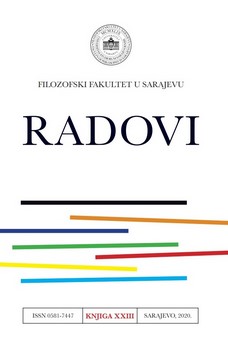PARADIGMA ITALIJANSKOG DRUŠTVA U ROMANU CRVENI KARANFIL ELIJA VITTORINIJA
A PARADIGM OF THE ITALIAN SOCIETY IN THE RED CARNATION BY ELIO VITTORINI
Author(s): Mirza MejdanijaSubject(s): Political history, Social history, Other Language Literature, Government/Political systems, Politics and society, Interwar Period (1920 - 1939), WW II and following years (1940 - 1949), Fascism, Nazism and WW II, Theory of Literature
Published by: Filozofski fakultet Univerziteta u Sarajevu
Keywords: fascism; censorship; Matteotti; fairytale imagery; myth; symbol;
Summary/Abstract: Following 1925, Italy was facing a downright fascist dictatorship. The ruling politics imposed dictatorship starting with oaths of faithfulness to the regime, all the way to newspapers and school textbooks censorship. The first novel by Elio Vittorini, The Red Carnation, was confiscated by fascist censors, then revised and edited by a Florentine official. The edited and censored novel was published for the first time in 1948 by Mondadori publishing and the version published was not the original version the author himself no longer possessed. The novel tells a story of a local youth, Alessio Mainardi, and his initiation into adult life. He lives in a student dormitory together with other boys of his age. He falls in love with a classmate, Giovanna, and even manages to kiss her on one occasion. As a token of her affection, Giovanna presents him with a red carnation that he keeps and holds dear. He is constantly holding onto this illusion of love and confides in his best friend, Tarquinio. The story in the novel takes place by the end of spring 1924, the days which are in Italy known for the Matteotti affair. Alessio and his friends consider themselves fascist. They attend protests against the Matteotti commemoration organised by antifascists. It is in this novel that Vittorini is trying to resort to a mythical transfiguration owing to which the narrative reality becomes fairytale-like, distant from time and space, without losing anything from its actual heaviness of the balance achieved between myth and reality. By means of a stylistic quest, Vittorini is trying to transfer history into a literary dimension in an allusive and symbolic way. He understands that his duty, as an author, is to transfer historical reality into symbols while the historical events depicted in the novel are the rise of fascism in Italy and Matteottiʼs murder. By means of fairytale imagery, myth and symbol, the author is trying to portray the reality in Italy at the time.
Journal: Radovi Filozofskog fakulteta u Sarajevu
- Issue Year: 23/2020
- Issue No: 1
- Page Range: 288-304
- Page Count: 17
- Language: Bosnian

